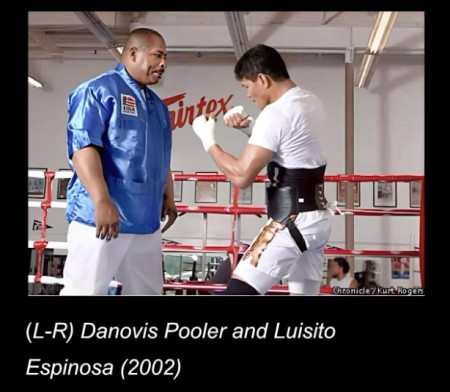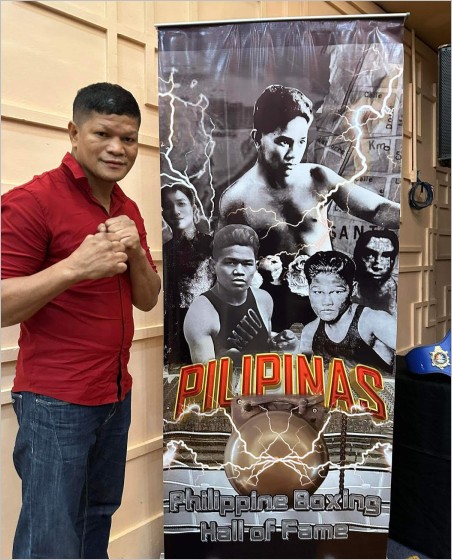
|
Philippines, 11 Nov 2025 |
Home >> News |
 |
||||
|
|
|
|
Luisito “Lindol” Espinosa and the Art of Playing Boxing By Emmanuel Rivera, RRT PhilBoxing.com Tue, 11 Nov 2025  “I will play boxing with you.”… Those were the words written more than a century ago by Joe Waterman, Manila’s foremost journalist of the 1920s and one of the founding fathers of boxing in the Philippines. In ‘The Referee’ of Sydney, Australia, he described Filipino boys sparring barefoot in the streets — boxing not for money or fame, but for joy. “To the Filipino boy,” Waterman wrote, “boxing is not fighting, it is playing. It is a game with him.” A game…A deadly one…The ultimate physical debate. I found myself living its meaning — discovering what it meant to “play boxing”…Not once, but on two separate occasions. And both times, I learned that three minutes inside a ring can feel longer than a semester in college. The first time was in 1988, inside our garage on Burdick Street in Newark, California. The ropes were improvised, the floor uneven, and the air heavy with vapors of sweat, ambition and curiosity. That’s where a soft-spoken young man from Tondo and Pangarap Village, Caloocan named Luisito “Lindol” Espinosa — not yet the legend he would become — laced up his gloves for a friendly play time against this aspiring writer. The deal was simple: I would go all out and that he wouldn’t retaliate nor hit me. He’d only play defense — a friendly exchange between my father’s fighter and a journalist’s son who thought he could keep up. I even wore my eyeglasses — a terrible idea, in hindsight. When the bell rang, all I saw was human blur. Luisito’s head slipped in and out of sight, his movements easy, smooth, almost musical. I threw a jab — he slid. I tried a hook — he disappeared. I hit nothing but air. Sometimes he’d let me tap him lightly on the head or arm, just enough to make me think I was doing something right. He smiled that quiet grin, studying each of my clumsy moves like a teacher amused by a beginner’s enthusiasm. That day I found out something no textbook explains: Every punch that missed the target drained me faster than one that landed. By the end of that single round, my flyweight frame (as Mr. Espinosa described my stats) was in pain and my lungs were on fire. 
My father, Hermie Rivera, didn’t see my feeble attempt at sparring, if I can call it that. He found out later and just laughed, shaking his head the way Luisito did after one of my wild swings. But curiosity has a funny way of loitering. Not long after, I foolishly tried again — this time with my buddy Ferdinand Busarang. He was a chef at the Holiday Inn in Union City who grew up as a street fighter on the tough streets of Manila; and he had that same Filipino instinct — the seriousness when someone says, “I will play boxing with you.” On one of our wild exchanges, Ferdie caught me clean on the chest with a jab-straight. My vision almost went blank and I thought I heard a whistle and realized it was coming from me. For almost a year afterward I battled bouts of pleurisy…a recurrent, disturbing and painful twitch of the chest wall — a stubborn reminder that boxing remembers and reminds what one forgets. When I told Luisito about it, he just smiled and said words I heeded: “Kalimutan mo muna ang boxing. Mag-aral ka na lang.”… Forget boxing, for now. Study instead — go finish college, he said. “Pag depensa…Huwag kang pipikit pag sumusuntok ka,” he said in Tagalog. “And if you ever have to defend yourself, try not to blink while you are punching,” he impressed upon me. I did exactly that, metaphorically. Thereafter, I tried not to blink when faced with life’s challenges, and listened to Espinosa and my father…got my degree in biology and later became a registered respiratory therapist, embarking on a career to help patients breathe easier. Decades passed. Around 2002, I found myself gloving up again — this time inside the main ring at Alex Gong’s Fairtex Gym in Daly City. I was once again face-to-face with Luisito who was preparing for his comeback. Team Espinosa had run out of legitimate sparring partners that day, so I filled in for one excruciating round. He jokingly wanted to see if I had improved after all the prior years. Not much had changed. Louie still moved with efficient offense and defense, with the same elegant footwork and rhythm that was his trademark. Me? I was going to stick with my chosen profession outside the ring. 
Photo by Kurt Rogers(2002), courtesy of SF Chronicle from an article by Cicero Estrella. That day we met Master Danovis “Dee” Pooler for the first time — a man who would later become our mentor in both life and boxing, someone who knew that every round, like every choice, has its own beat. Luisito again agreed to strictly play defense. Those two rounds — one in Newark, one at Fairtex — became the longest six minutes of my life. They taught me humility and the holiness of breathing and health. 
An aspiring writer poses with Luisito Espinosa — one of only seven boxers since the 1890s to win both bantamweight and featherweight crowns, remembered for his quiet strength and enduring grace. (Manila Grand Opera Hotel — March 23, 2024) Three and a half decades later, on March 23, 2024, at the Gala of Champions inside the Manila Grand Opera Hotel, life came full circle. I had the rare honor of returning Luisito Espinosa’s long-lost championship belts — faithful replicas of the WBA Bantamweight and WBC Featherweight titles he once held. In tribute, the Philippine Boxing Historical Society and Hall of Fame added one more — a blue commemorative belt, offered in his name by friends and disciples who never stopped believing in him. That humble demeanor was still there — the same footwork, the same grace that carried him through every storm. Luisito and I didn’t say much. We didn’t need to. Our tears said it all. 
Louie at the Gala of Champions Exhibit (Manila Grand Opera Hotel — March 23, 2024) Luisito Espinosa, the man we called “Lindol”, continues his boxing life now as a coach, trainer, and quiet role model, sharing the wisdom he learned both inside and outside the squared circle. It’s the highlight of his story — to rise from the canvas, to make himself the living example of a warrior who never gave up on himself. He was — and remains — one of only seven men since the 1890s who have won both the bantamweight and featherweight world titles before retiring — a rare feat that places him among the fight game’s greatest champions. At his peak, Luisito Espinosa made boxing look like play — and that, perhaps, was his best gift to boxing aficionados, my father and I included. Acknowledgements, Sources and Recommended Readings: • Top Photo of Luisito Espinosa by one aspiring writer (circa July 1988, Señor Miguel Jara’s Star Boxing Gym @Alum Rock Avenue, San Jose, California). • Joe Waterman, Referee (Sydney, NSW : 1886 - 1939), Wednesday 7 January 1920, page 11. EVOLUTION OF THE FILIPINO BOXER: Where Silvino Jamito Came From: Others as Good, If Not Better Click here to view a list of other articles written by Emmanuel Rivera, RRT. |
|
|
PhilBoxing.com has been created to support every aspiring Filipino boxer and the Philippine boxing scene in general. Please send comments to feedback@philboxing.com |
PRIVATE POLICY | LEGAL DISCLAIMER
developed and maintained by dong secuya © 2025 philboxing.com. |